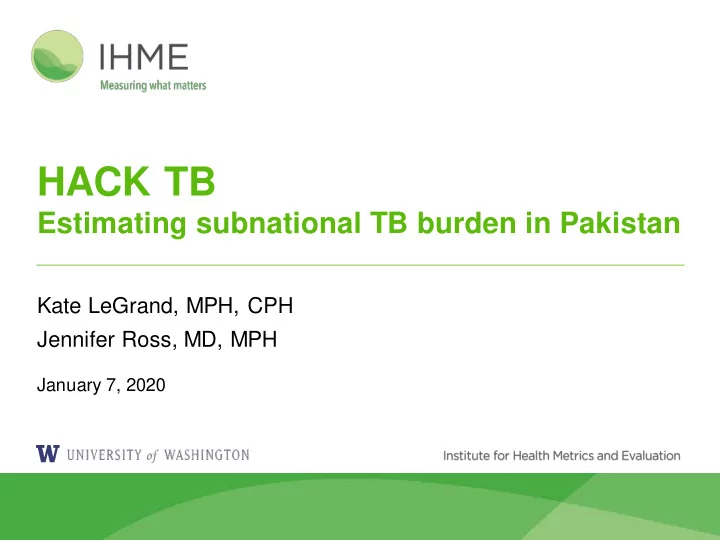

HACK TB Estimating subnational TB burden in Pakistan Kate LeGrand, MPH, CPH Jennifer Ross, MD, MPH January 7, 2020
Overview 1. Tuberculosis epidemiology 2. Sources of data 3. Data challenges in the TB landscape 4. IHME geospatial modeling methods 5. Case study in spatial TB modeling 2
TB Epidemiology Tuberculosis is the top infectious killer in the world Globally, 1 in 4 is Fell ill with TB in 2018, Eight countries account In 2018, 1.5 million died infected and at risk of with 3 million undiagnosed for 2/3 of all incident from TB including 251,000 developing TB disease. or unreported cases. cases. people with HIV. Source: WHO Global tuberculosis report, 2019 3
Ending the epidemic requires data • To identify priority populations for interventions • To establish rates of progress • To predict future trends and advocate for resources Source: ESRI 4
Data Sources • Data Library Services o Data Curators, Specialists, Analysts o Seek and intake data from a variety of sources ─ Public vs. Private availability ─ Data ownership o Maintain the Global Health Data Exchange ─ GBD Compare • Network Engagement o Develop key relationships around the world o Collaborator network 5
TB models leverage challenging data Metric Challenge Case notifications are a biased estimate • Care seeking, diagnostic limitations, Incidence incomplete reporting Sparse data, as national prevalence surveys Prevalence are expensive to implement • No point-of-care test Vital registration systems are not present in Mortality most high-burden countries 6 WHO Global TB Report, 2019
Global vs. Local Burden of Disease • Location matters o National (or even subnational) averages may obscure finer-scale geographic trends Admin 2 National Admin 1 5x5 km (e.g. local gov areas) (e.g. state) 7
IHME Geospatial Modeling • Small area estimation • Model-based geostatistics o Administrative areas o Points (polygons) o Use observed data to make prediction (and uncertainty estimate) for areas that are o Draw strength to estimate from neighboring unobserved regions, years, and ages Golding, Burstein, et al. Lancet . 2017 8
KIT TB Hackathon 2019 Video link • Collaboration between KIT Royal Tropical Institute, Stop TB Partnership, and the Pakistan National Tuberculosis Control Program • Data: 2010 NTP survey and any publicly available data source • Goal: Estimate district-level prevalence in 2018 • Teams: IHME, IDM, EPCON, Univ. of Sheffield, and Univ. of Milan • Presentation: The Union World Conference for Lung Health, India 9
Epidemiological covariates • Created a custom covariate for conflict and violence o Conflict (riots + protests) and violence against civilians The Independent (UK) 10
Epidemiological covariates • Access: Travel time to nearest settlement (Weiss, et al ., Nature. 2018) 11
IHME Pakistan Geostatistical Model Results • Results o National prevalence, age 15+, decreased from 2010 to 2018 o District-level prevalence range varied greatly across the country o Model accurately predicts points with high-prevalence o Model over-predicts areas with low prevalence and sample sizes which proved to be a challenge across competitors o Wide uncertainty in unsampled areas 12
HACK TB Estimating subnational TB burden in Pakistan Coordination: Team members: Internal review: Funding: • • Pakistan National TB JMR: National Institute of Audrey Batzel Zahid Butt Program Allergy and Infectious Brigette Blacker Simon Hay Diseases, National Institutes • KIT Royal Tropical of Health Nat Henry Hmwe Kyu Institute • IHME: Bill & Melinda Gates • Kate LeGrand Jorge Ledesma Stop TB Partnership Foundation Bobby Reiner Ali Mokdad • International Union Against Tuberculosis and Jennifer Ross Lung Disease Data curation: Emma Spurlock Mingyou Yang Karly Williams Kate E. LeGrand, MPH, CPH Jennifer M. Ross, MD, MPH Geospatial Tuberculosis Data Extraction Analyst Acting Assistant Professor, International Clinical Research Center Institute for Health Metrics and Evaluation UW Departments of Global Health and Medicine (Infectious Disease) kel15@uw.edu Visiting Faculty, Institute for Health Metrics and Evaluation Jross3@uw.edu 13
Appendix • Discussion themes • Model selection and validation • Model equation • Data challenges in the TB landscape • Case study results 14
Model selection and validation 15
Model Equation • Spatially explicit linear regression • Assumed binomial distribution of bacteriologically-confirmed TB cases detected in a cluster Probability of having Probability of having Intercept for spatially- Vector of fixed-effect TB in a particular TB when all covariates correlated residual coefficients for set of space-time location are equal to zero variation that is not space-time covariates accounted for by fixed effect terms 16
Recommend
More recommend